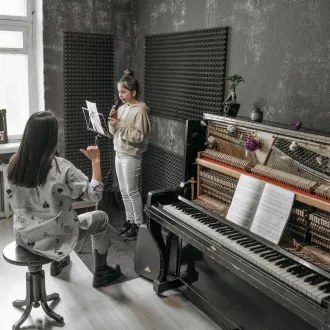Transcription Body-voice relationship
Effective communication is a fundamental skill in many areas of life, and one of the most powerful tools for achieving it is public speaking. However, a crucial aspect of public speaking is often overlooked: the relationship between the body and the voice. The body and voice are intrinsically linked, and understanding how they interact can make the difference between an impactful speech and a mediocre one. In this session, we will explore the importance of the body-voice relationship and provide practical tips for making the most of this connection.
The importance of the body-voice connection
The body is a channel of expression: our gestures, postures and movements convey powerful messages to the audience. The voice, on the other hand, is the primary vehicle for delivering our message verbally:
- Congruence:When the body and voice are in harmony, a congruence is created that increases the credibility and impact of our speech.
- The influence of posture on the voice: Body posture directly affects the quality and projection of the voice. An upright and open posture facilitates proper breathing and improves vocal resonance.
How to improve the body-voice relationship
Body awareness: Before speaking in public, it is essential to become aware of our body. Paying attention to breathing, posture and muscle tensions helps us connect with our inner voice.
Diaphragmatic breathing: Proper breathing is the basis for good vocal projection. Learning diaphragmatic breathing techniques allows us to control our voice and avoid vocal tension.
Relaxation: Body tension negatively affects the voice. Practicing relaxation techniques, such as gentle stretching and muscle relaxation exercises, helps to release tension and improve vocal fluency.
Mindful movement: Using the body intentionally during a presentation can be very effective. Gestures and movements should be natural, consistent with the message and emphasize key words.
Voice as a reflection of the body
Vocal resonance: The body is the natural resonator of the voice. Resonance occurs when sound is amplified and enriched as it vibrates in different parts of the body, such as the chest, throat and head. Learning to use resonance properly improves the quality and range of our voice.
Pitch and intonation: Our emotional and physical state influences the pitch and intonation of our voice. Practicing relaxation techniques and consciously managing our emotions can help us modulate and control our voice effectively.
Vocal projection: Vocal projection refers to the ability to make the voice clear, strong and audible to the audience. Good vocal projection is achieved by using proper breathing, upright posture and conscious vocal support.
The body-voice relationship in public speaking is critical to delivering messages effectively and persuasively. The body and voice must be in sync to achieve congruent and powerful communication. By becoming aware of our body, practicing breathing and relaxation techniques, and using movement and vocal resonance consciously, we can enhance our speech and connect more deeply with our audience. Integrating the body-voice relationship into our public speaking skills will help us communicate more confidently and make an impact in any situation.
relationship body voice




